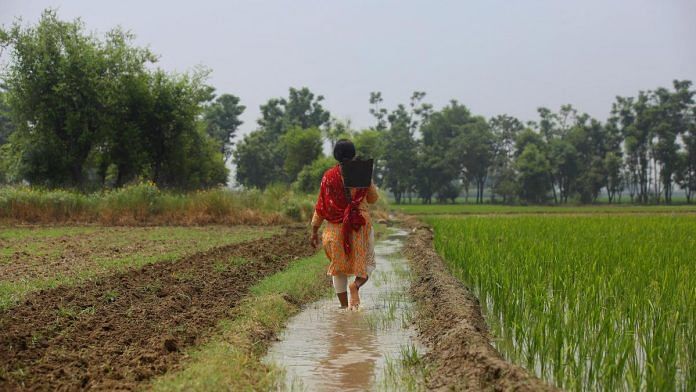Sangrur: Jasveer Kaur arrives on a shiny blue tractor and climbs down, her torn chappals sinking into the tilled soil. With glittering eyes and a faint smile, she surveys the newly planted paddy crop. “This land is ours,” she said proudly.
It took Kaur several years of struggle to reach this moment. The seven acres of land in Sangrur’s Herike village aren’t in her name, but she fought and won the right to farm it. In village after village in the Malwa region, Dalit women like her are demanding what was long denied.
They have already leveraged a 1961 law and turned it into a rallying cry for land, dignity, and ownership. The fire of hakk, or rights, is burning in their bellies. Now, Jasveer and hundreds of other women are part of a fresh agitation to claim 927 acres of unused estate land in Bir Aishwan village. They are marching, protesting, and courting arrest to demand a new settlement: Begumpura, a casteless village imagined by poet-saint Ravidas.
“The Constitution of India has given us the right to own land, then why are we not given land just because we are from a lower caste?” said 41-year-old Jasveer. “We are born on this land and we have every right to have a piece of it.”
Mustard fields, the Green Revolution, and, more recently, the farmers’ protests are the stories most associated with farming in Punjab. But beneath this image is a fraught history of caste discrimination. Dominant castes—primarily Jat Sikhs, along with Kamboj and Saini Sikhs—have sway over most of the farmland. Dalits, who make up about 32 per cent of Punjab’s population, own just 3.5 per cent of the state’s land. Most work as daily-wage labourers through heat waves and biting cold for around Rs 300 a day, planting and harvesting crops they have no claim on.
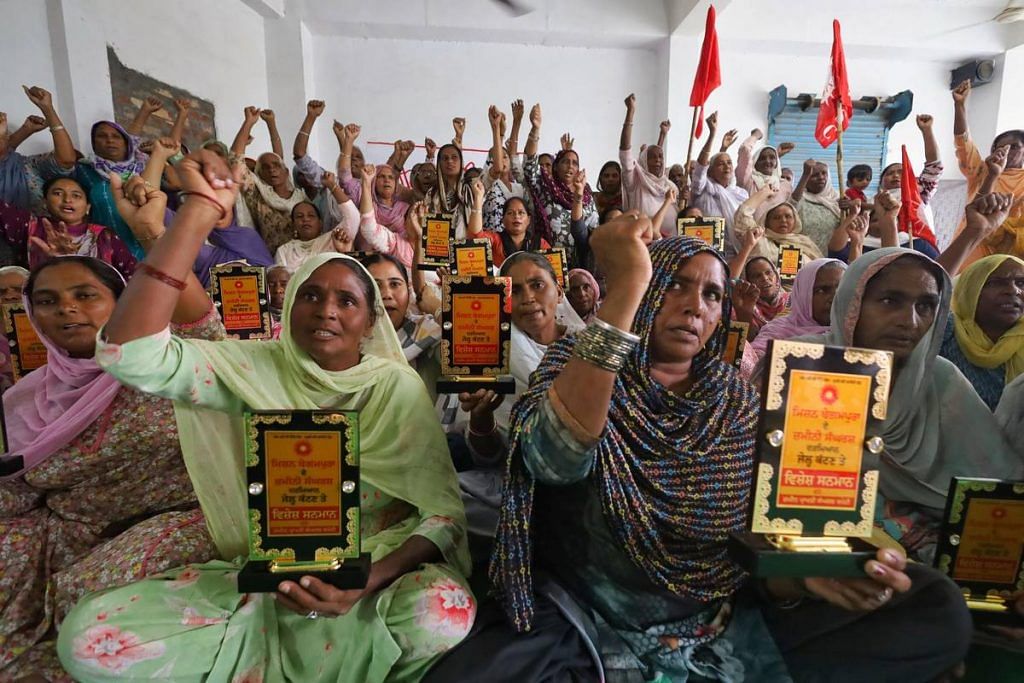
But then, the Dalits in rural Punjab started fighting back. Their first weapon was a law that Punjab had passed in 1961. Under the Punjab Village Common Lands (Regulation) Act, one-third of village common land—known as panchayat land or shamlat deh— to be allotted to Scheduled Castes or Dalits for agricultural use. On paper, it gave Dalits the right to lease and farm these plots through panchayat auctions. In practice, the land stayed in the hands of dominant castes through dummy bidders and threats.
The first major pushback came in 2008, when Dalit labourers in Benra village, Sangrur, took over panchayat land. In 2014, the Zameen Prapti Sangharsh Committee (ZPSC) began organising across the region, turning scattered protests into a coordinated campaign.
Dalit women emerged as the heroes of this uprising. In their chappals and salwar-kameez, they stood on the roads, held up placards, and demanded their land. They faced off against Jats and other Chaudhrys (landlords) and braved arrests and beatings. The fierce battle spread like wildfire across the state.
We women did not tell our husbands about the abuse we faced every day on the paddy fields because we feared we would not be allowed to work. Today we are here fighting for land
-Jasveer Kaur, farmer from Sangrur
In the Malwa region alone, Dalit families are now cultivating around 4,000 acres of land, according to the ZPSC. And now, many like Jasveer are demanding more. They are fighting for be-chirag (heirless) land to be redistributed to landless Dalits.
The grit of Punjab’s Dalit women comes from years of daily indignities and casteist slurs on farms where they laboured or collected fodder. Today, they know they don’t have to tolerate it.
“Dalit women have faced exploitation in the fields. They reared cattle and gathered fodder from the lands of the dominant caste,” said Ronki Ram, political science professor at Panjab University. “They did not want to depend on others’ land anymore and be subjected to everyday exploitation.”
Also Read: More and more Muslims from UP, Bihar, Bengal migrating to Punjab. New mosques dot the skyline
From a ‘nightmare’ to victory
Until four years ago, Jasveer Kaur was just another woman in Herike village—feeding cattle, collecting fodder, raising her children, and working on a landlord’s fields. Her husband sold food from a thela, and the family scraped by on her daily earnings of Rs 300 from farm labour and selling milk. Men in the gurdwara called her “Churu Chamar”. Now she says they worry that Dalits like her might soon be called something else: landowners.
On a pleasant July morning, the monsoon breeze brushed Jasveer’s hip-length hair as she briskly combed it. She was getting ready for a day in the fields. On such days, she likes to plait her hair. She gulped down three rotis with aloo ki sabzi and drank a glass of chilled water. Then she picked up her bright red dupatta and rushed to feed her three buffaloes—the mother, the father, and their newborn daughter.
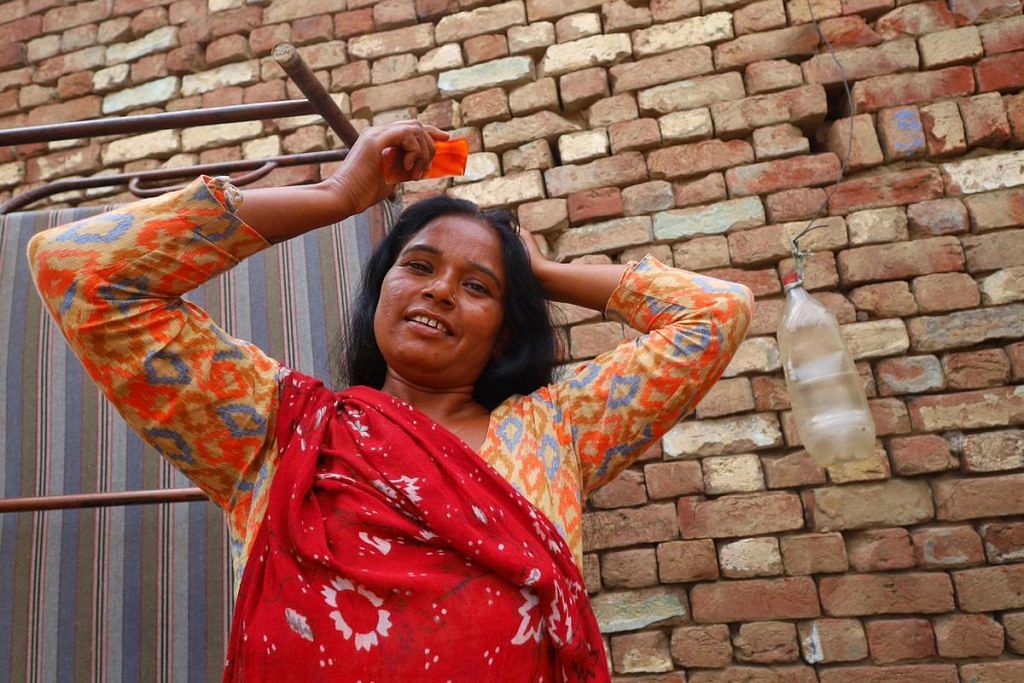
“Till three years ago, I was working at the farmland of the Chaudhrys. I used to collect the grass to feed the cattle from their field,” she said, as she scattered bhusa (fodder) for the animals.
In many villages here, Dalit families rely on a mix of cattle rearing and daily-wage labour. Selling milk brings in some income, but fodder is always a challenge. For years, women like Jasveer gathered grass from the dominant caste’s fields and were regularly insulted for it.
“It was a nightmare. It was usual for them to use abuse targeting our mothers and forefathers,” she recalled.
Jasveer’s transformation began when members of the Zameen Prapti Sangharsh Committee came to Herike in 2021. She had never heard of the 1961 land law before. For the first time, someone told her she had a right to the soil beneath her feet. That same year, she and 14 other Dalit families in the village raised their voices during a panchayat land auction. They sat on dharnas and refused to work on the fields. After two years of pressure, the gram panchayat relented. In 2023, the land was formally leased to them.
We work on your land, we take your harvest to the mandis, we take care of the crop, water them, protect them, and the Chaudhrys and Jats think we are untouchables
-Jasveer Kaur
Dalit women, unlike many of their upper-caste counterparts, have always worked outside the home and thus have fewer inhibitions about public confrontations, according to Ranjit Singh Ghuman, economist and retired professor of Punjabi University, Patiala.
“The SC women were already working in the field alongside the men. They were also working in MNREGA,” he added.
Today, Jasveer and the others farm the land as a collective. They started by planting grass for their cattle. This season, the fields are full of paddy. She earns around Rs 7,000 to 10,000 a month, and is expecting a profit this year. Her family lives in a two-room house built on panchayat land allotted for housing. When she first came here as a bride, the house would flood each monsoon. Now, it’s been rebuilt with bricks and freshly painted.
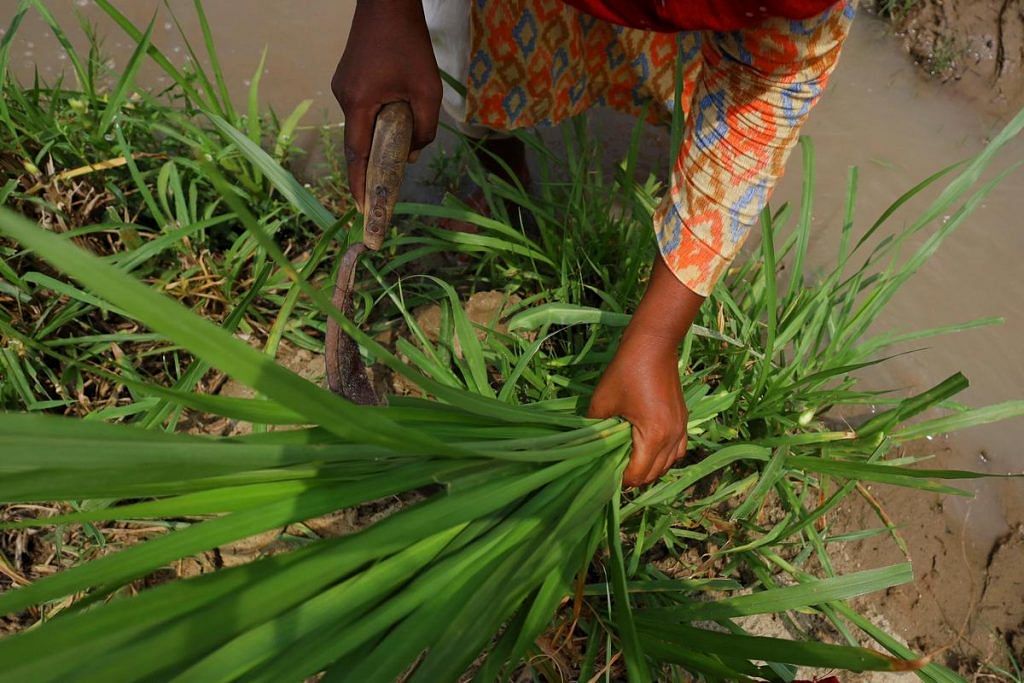
“We don’t own this land—it was given to us to build a house,” said Jasveer. “If we have a steady income from the farmland, we’ll renovate the house properly.” She’s ensuring a life of upward mobility for her children, with two sons in college and a daughter studying for her PhD.
Jasveer starts the scooty she bought two years ago. The paddy fields are a few kilometres away, past the Dalit households at the edge of the village.
After a ride down the narrow bund between two fields, she parks her scooty under a tree where a few men from the collective are waiting.
“I love challenges, and I have never stopped myself from taking them on,” said Jasveer with a bright smile.
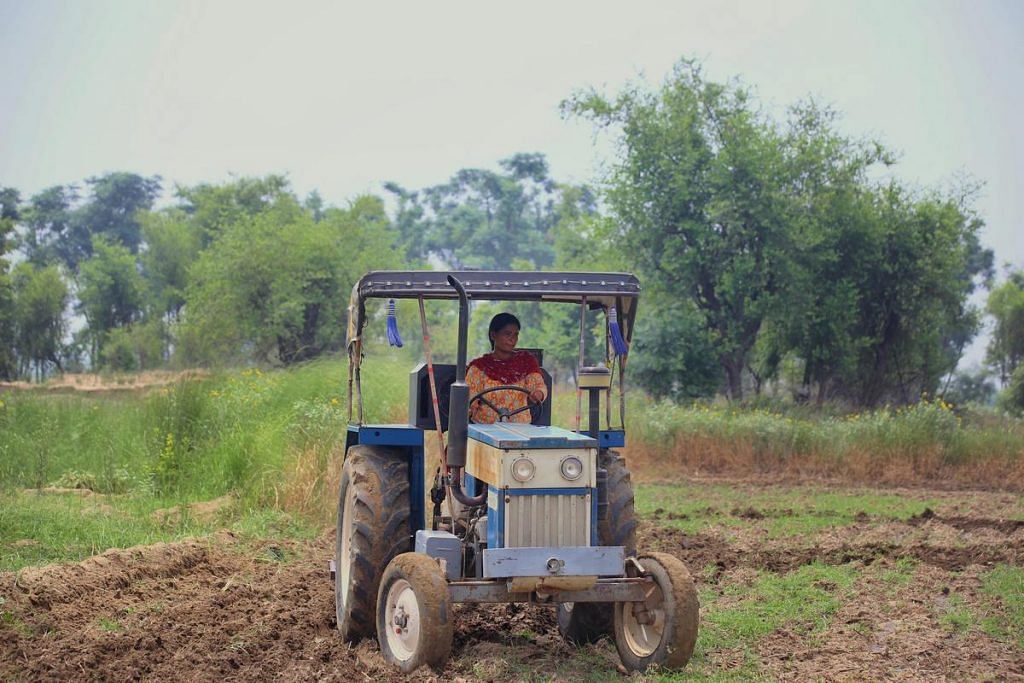
A fight over land and caste
When the announcement for the panchayat land auction went out over the village loudspeaker in 2021, Jasveer Kaur didn’t ignore it like she usually did. This time, she made her way to the village square, where government and panchayat officials were in attendance. It was her first time there. A local Chaudhry spotted her and scoffed.
“How can you ask for property? You don’t even have money for the bid,” she recalled him saying.
But even after the Dalit residents were given the lease, slurs like chhoti jaat are still used openly in Herike. The unfairness of it all rankles Jasveer.
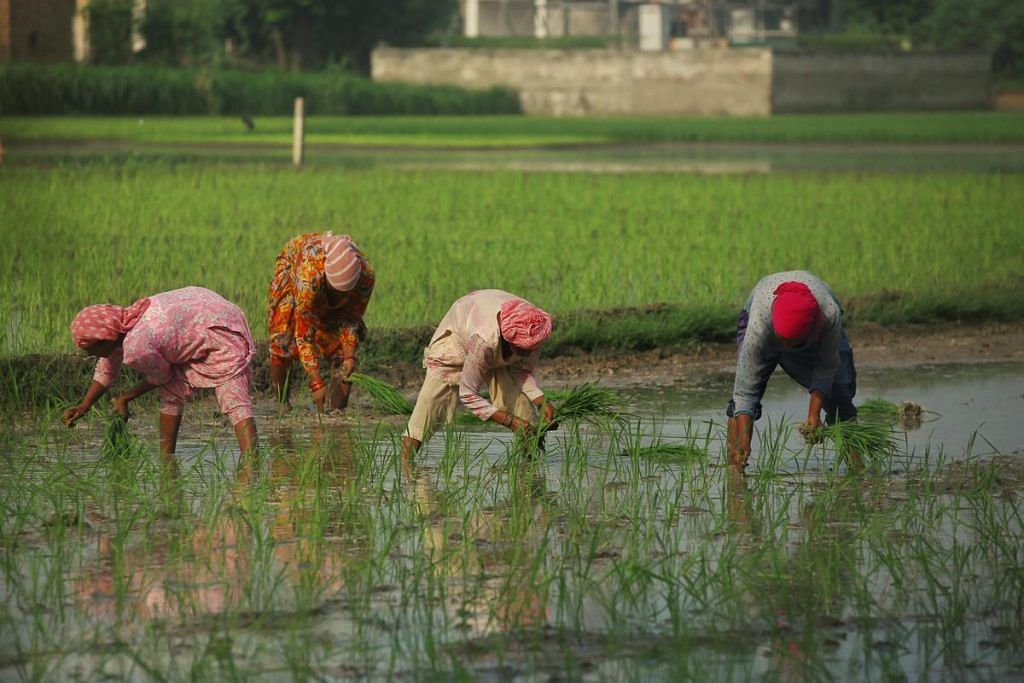
“We work on your land, we take your harvest to the mandis, we take care of the crop, water them, protect them, and the Chaudhrys and Jats think we are untouchables,” said Jasveer, as she grabbed the tractor keys from a male counterpart.
That anger over caste structures began slowly coalescing into a movement in Punjab’s Malwa region decades ago. Large tracts of land here had once belonged to princely estates like Patiala and Malerkotla. After Independence, some of it was handed to landlords, while the rest was vested in panchayats as common land. But dominant castes found ways to usurp it, often by planting proxy Dalit bidders.
Women became an important part of the movement and stood at the forefront. Even today, from organising protests to leading marches, women are standing in the fight. They get beaten by police lathis, yet they never get deterred
-Mukesh Malod, ZPSC leader
Left organisations tried to mobilise Dalits in the late 2000s, but it was only in 2014 that the campaign truly took shape. That year, grassroots activists formed the Zameen Prapti Sangharsh Committee (ZPSC), which began encouraging Dalit families to bid collectively. Without rival bidders, lease rates remained affordable, and the land was farmed cooperatively.
Since then, the movement has reached thousands of villages, according to the ZPSC, with women taking up the cause in a big way.
Raj Kaur, from Badrukhan village in Sangrur, was one of the first women to join. She and four others attended a ZPSC gathering, and something clicked.
“Looking at us, 15 more women came with us. Today, we have around 50 families from the village with us,” said Raj Kaur, adding she now earns enough to support her family.
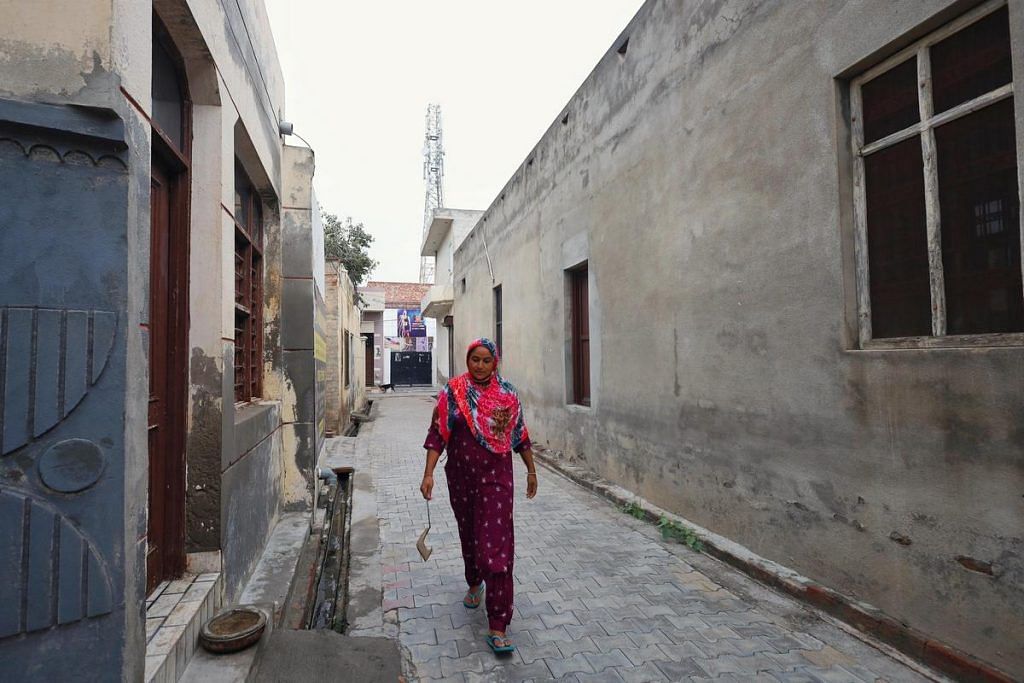
But the assertion of land and caste rights has met stiff resistance, not just from Jats but also the state machinery.
In June 2014, Dalits in Balad Kalan tried to stop dominant caste villagers from cornering land in an auction. The police lathi-charged the protesters and arrested 41 people, jailing them for nearly two months. At the same time, Jat Sikh villagers attacked Dalit homes and allegedly even beat and molested women.
In response, activists led rallies and street meetings. They went to Dalit homes and made loudspeaker announcements about the common lands law. There were protests in other parts of Punjab as well. Ultimately, the panchayat relinquished control of 121 acres of land to 143 Dalit families.
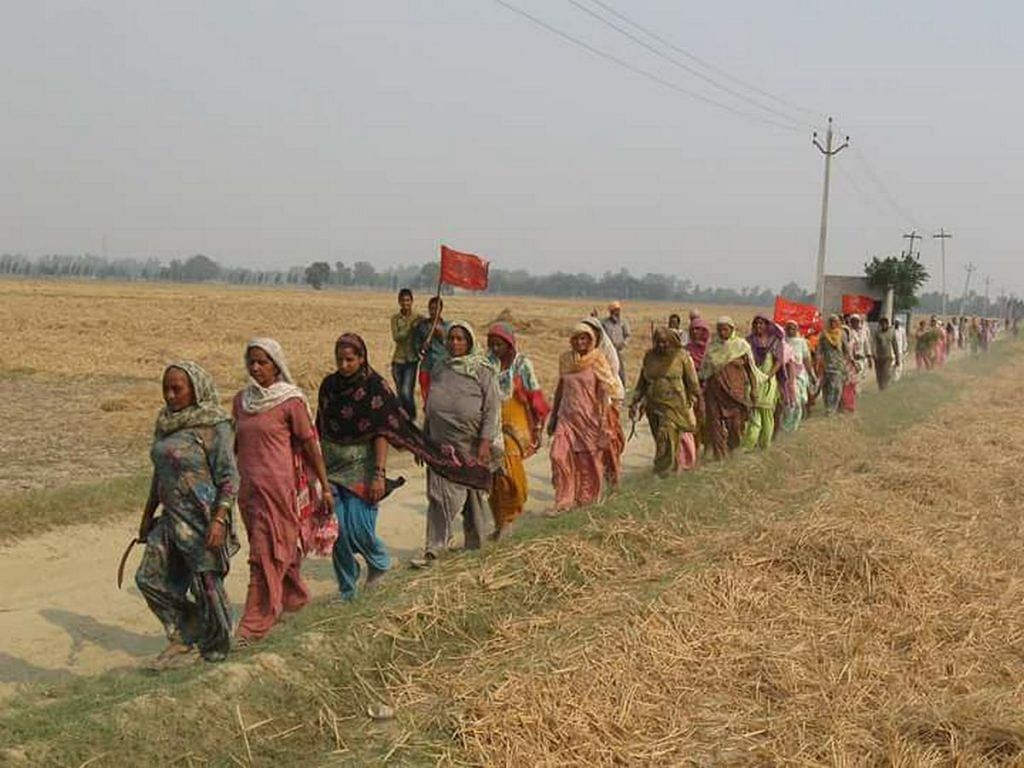
This spurred agitations in other villages, but clashes continued to flare up. In October 2016, several Dalits from Sangrur’s Jalur village were injured after they were attacked by a group of landlords while returning from a dharna to demand a lease on 6 acres of common land. A month later, one of the women, 70-year-old Gurdev Kaur, succumbed to her injuries. The ZPSC called her the “first martyr” of their uprising.
“Around 35-40 people were injured in the protest that happened in Jalur village,” said ZPSC leader Mukesh Malod. “Women became an important part of the movement and stood at the forefront. Even today, from organising protests to leading marches, women are standing in the fight. They get beaten by police lathis, yet they never get deterred.”
But there are also fissures within the Dalit community.
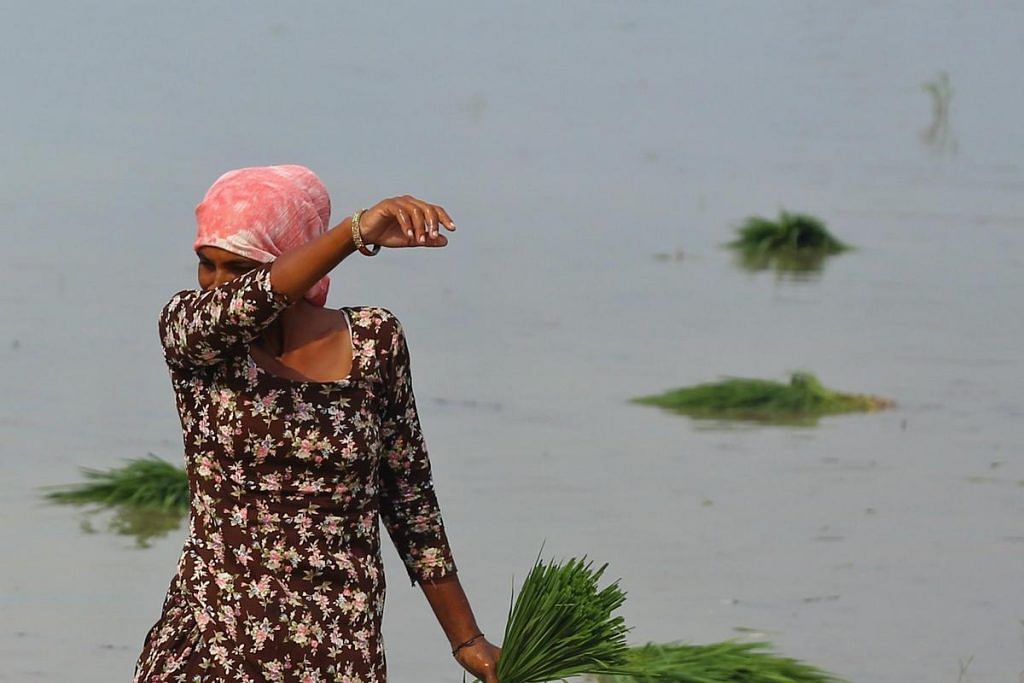
Dalits vs Dalits
Under a tree in Patiala’s Mandour village, about 20 Dalit women are sitting on a round-the-clock protest. They’re demanding their share of 39 acres of panchayat land, which they say was snatched from them through a dummy auction.
In Punjab, Dalit unity isn’t a given. The Scheduled Castes are internally fragmented, with rival groups often split by caste subgroups, political affiliations, and survival strategies. Political scientist Ram has described this as “caste within caste”, where parties like the Congress and Akali Dal have historically courted different Dalit subsets, weakening collective mobilisation.
That division is playing out in Mandour. Last year, Sukhvinder Kaur and Satpal Singh, both Dalits, jointly farmed 39 acres of common land. But this year, they’re standing on opposite sides.
Sukhvinder is now accusing Satpal of working in cahoots with the panchayat head Harpreet.
The upper caste has created a rift between Dalit brothers
-Sukhvinder Kaur, Mandaur village
Matters came to a head during the annual auction on 9 June, when the land was awarded to Satpal and about 50 families associated with him. Sukhvinder and 250 other families were declared defaulters from the previous season. It was later decided that 13 acres would go to Sukhvinder’s side, but she says they will only settle for equal distribution of land.
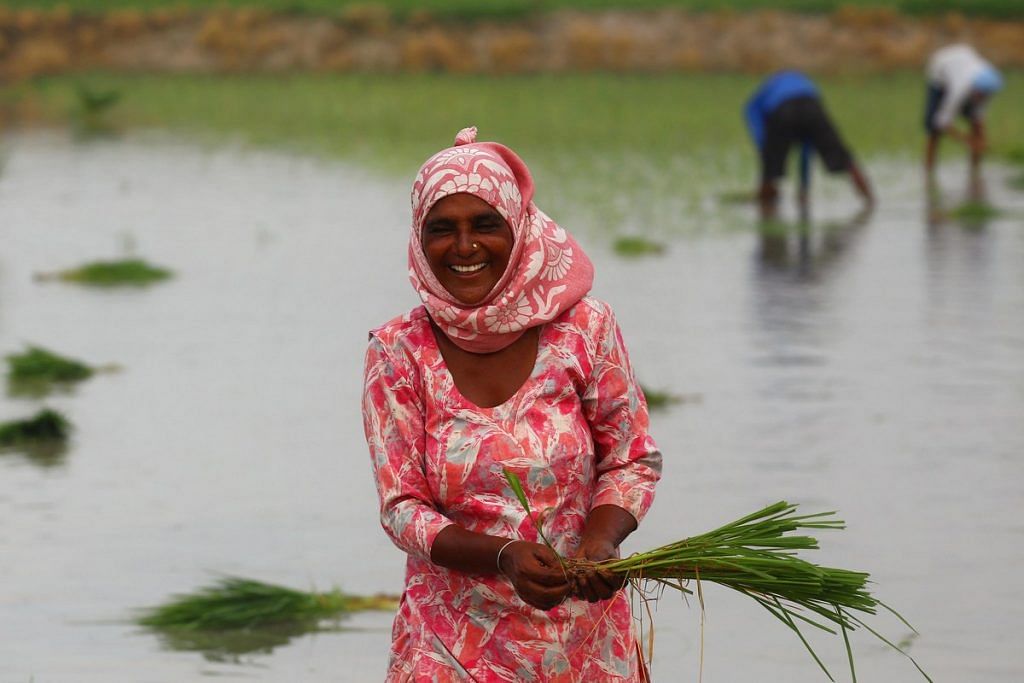
“There are high chances the land will be given to some thekedar for farming and Satpal won’t use it. This is what used to happen in proxy auctions,” said an irate Sukhvinder. “The upper caste has created a rift between Dalit brothers.”
Harpreet, however, denied that any wrongdoing had taken place or that a rift had been strategically created between Dalit groups.
“If they had the money, why didn’t they pay on auction day?” asked Harpreet. “These people are disturbing the peace of the village. If they default today, tomorrow those from the general category will also stop paying on time. That will affect the finances of the village.”
But paying upfront isn’t always easy for Dalit families. Most depend on daily wages or cattle rearing. They rarely have the money needed for leases, fuel, or seeds, let alone technology at par with their more privileged neighbours.

The culture of discrimination has also been hard to shake.
“We got the land, but the abuse did not stop,” sighed Jasveer Kaur. Her feet deep in the water of the paddy field, she starts cutting the grass that has grown on the embankment for her cattle.
She has to be careful. The bund or embankment isn’t clearly owned, so it’s treated like a battleground for petty power plays.
“The Jats and Chaudhrys spray pesticide on the grass grown on the bund so that we do not cut it,” she said.
Jasveer quickly wraps up her work and changes into a crisp white kurta with a green dupatta. She’s headed to an event in Sangrur city, part of the ongoing agitation over Begumpura—a cause that landed her in jail for a week in May.
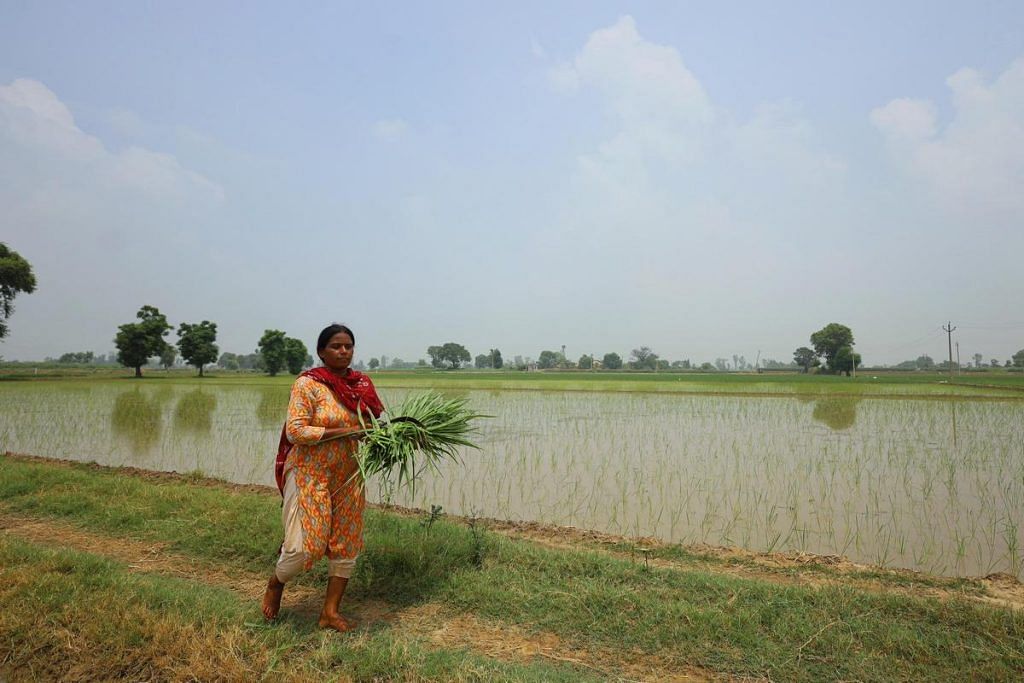
Also Read: Punjabi Christian pastors are mixing Bible with bhangra. Making Jesus relatable
Demand for a ‘village with no sorrow’
The fight for panchayat land is morphing into something bigger. This time, the demand is not just for farmland but for a more secure future. Protesters want to build a new settlement, Begampura, on 927 acres of unused estate land in Bir Aishwan village near Sangrur.
The property belonged to the titular king of Jind who died without an heir in 2023. This time, the ZPSC is invoking the Punjab Land Reform Act, 1972, which caps ownership at 17.5 acres.
On 28 February, thousands of men and women marched to the village. They beat drums, danced, lit chirags, and symbolically took over the be-chirag (heirless) land, demanding that it be converted to public land and redistributed to landless Dalits. Once again, this was not just about land but about caste assertion. They chanted Kanshi Ram’s slogan, “Jo zameen sarkari hai, wo zameen hamari hai” (The land that belongs to the state belongs to the Bahujans) and spoke of building Begumpura, the ‘land without sorrow’ imagined by Ravidas and enshrined in the Guru Granth Sahib.
And it’s not just Bir Aishwan. The ZPSC has reportedly identified 153 other villages across Punjab with large tracts of be-chirag land that they say should be redistributed.
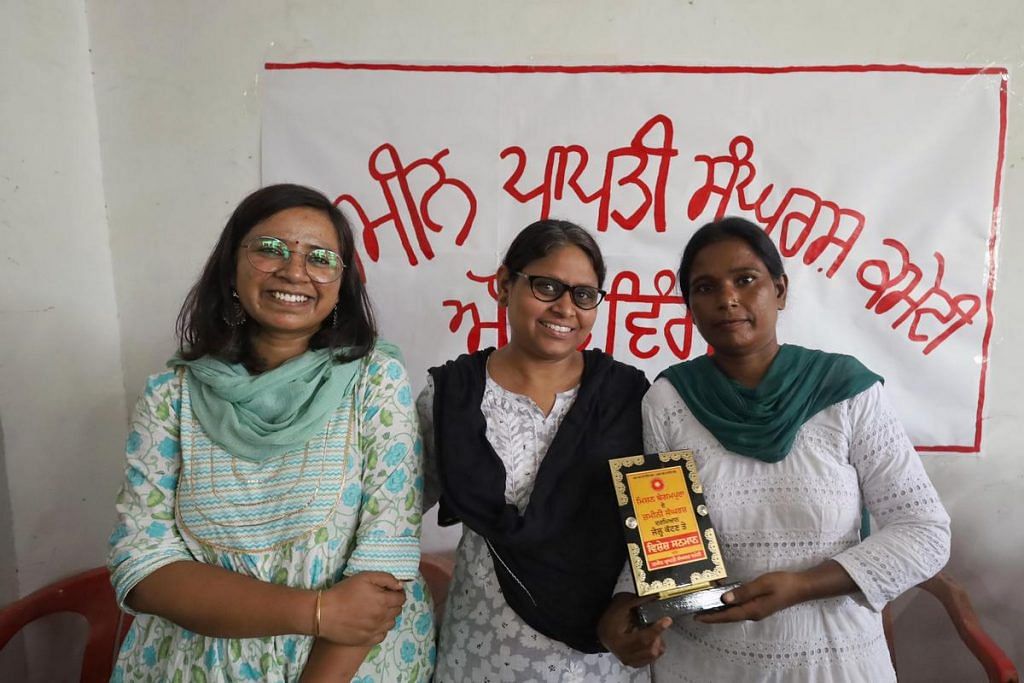
But much like the panchayat land struggle, this too has triggered a crackdown.
During a march to Bir Aishwan on 20 May, at least 200 men and women—including Jasveer— were placed in preventive detention. A few days later, many started a hunger strike from jail and claiming inhumane treatment.
Sandeep Rishiji, deputy commissioner of Sangrur, told ThePrint that more than 650 acres of the land in question are classified as protected forest.
“The rest is disputed,” he said. “I’ve told the organisation [ZPSC] that they cannot claim the land like this. If they want it, they should come in the proper way.”
But this time too, the women of Sangrur are keeping the flame burning.
On 10 July, more than 60 women gathered at Guru Ravidas Gurudwara in Sangrur. They all said the same thing. This was a fight for land to feed their children. A fight for respect.
Jasveer Kaur and Raj Kaur, who are leading the movement, addressed the crowd. They raised slogans demanding Begumpura. On every lip was the cry: “We want our rights.” Women who had been arrested were honoured with mementos that lauded their protest during the Begampura agitation.
“We women did not tell our husbands about the abuse we faced every day on the paddy fields because we feared we would not be allowed to work. Today we are here fighting for land,” said Jasveer Kaur. “We will have our own land someday, where we do not need to pay anyone.”
(Edited by Asavari Singh)


